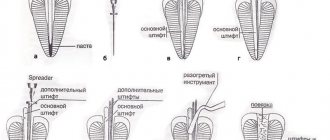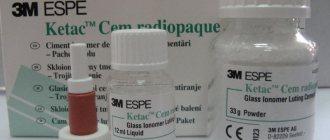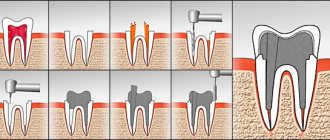Root canal filling – this method is used in dentistry in the treatment of dental diseases such as pulpitis or periodontitis. Before filling the canals, they are always subjected to antiseptic and mechanical instrumentation. The latter allows you to expand the lumen of the root canals and make their walls smoother - without which their high-quality filling is simply impossible. Filling of the canals is carried out using radiopaque materials so that the doctor can evaluate the quality of treatment using radiographs.
Most often, gutta-percha pins are used for this in combination with a special sealer (paste). Only a high-quality filling can prevent the subsequent proliferation of infection in the root canals, as well as at the apex of the tooth root. And well-filled root canals of teeth must meet a number of criteria, which we will discuss in this article. We will also talk about the main mistakes dentists make, each of which we will demonstrate to you on targeted X-rays.
Important: at the moment (according to official statistics) filling of root canals in the treatment of pulpitis and periodontitis in 60-70% of cases is performed poorly by dentists. This subsequently leads to the development of inflammatory complications and even tooth extraction - in the short and long term, respectively. Retreatment of such teeth is very expensive, because... associated with the need for their preliminary unsealing, after which they are re-sealed.
Features of dental canal treatment
Differences in the structure and functions of the “representatives” of the dentition largely determine the nature of the treatment approach. Treatment of canals for different groups of teeth has its own nuances.
Front tooth canal treatment
The front teeth most often have one canal. They are often curved and difficult to pass through for instruments. In order to preserve aesthetics, the opening of the cavity of these teeth is carried out from the vestibule of the oral cavity. Due to their frontal location, it is important to prevent tooth enamel from darkening, so filling materials containing dyes are not used.
Treatment of wisdom tooth canals
Wisdom teeth can have more than 5 canals; they often have a branched structure, which is not always revealed by x-ray examination. These factors, along with the marginal location of the “eights”, significantly complicate the high-quality treatment of root canals. At the final stage of treatment, various filling pastes are traditionally used.
Root canal treatment of temporary teeth
Endodontic treatment of tooth root canals is usually used only at the stage of root stabilization. When choosing the optimal treatment tactics, it is necessary to take into account the specific structure of temporary teeth. The small thickness of the canal walls, the insignificant degree of dentin mineralization and the relatively large size of the apical foramen are the main reasons for special caution during instrumentation. Zinc oxide eugenol and iodoform pastes, as well as materials based on calcium hydroxide, are usually used as filling agents. They are not toxic to the permanent tooth germ and are able to dissolve along with the temporary root.
Choosing a paste for prevention
Dental health should be taken care of from early childhood. The most effective way is prevention and regular teeth cleaning.
For daily use you need to choose a toothpaste. With a variety of options to choose from, your dentist can recommend the right one for your teeth type. To avoid the addictive effect, it is recommended to periodically change the toothpaste.
Hygienic toothpastes do not have medicinal properties and are intended for everyday use. Daily use of hygienic pastes ensures cleansing of the oral cavity from food debris after eating, removes surface plaque, and has a short-term refreshing effect.
Medicinal pastes should be used as prescribed by a doctor, since they contain high concentrations of medicinal substances, and it is not recommended to use them constantly. The use of medicinal pastes helps fight the development of caries and inflammation in the gums.
Therapeutic and prophylactic are suitable for regular use. They contain active medicinal substances and natural ingredients, but in smaller quantities.
A small amount of toothpaste (about the size of a pea) is enough to effectively brush your teeth and prevent large amounts of toothpaste from ending up in your stomach. It is important to remember that to get results from toothpaste, you must use your toothbrush correctly and change it every three months. The toothbrush is selected depending on the condition of the teeth and oral cavity.
Stages of tooth canal treatment
Endodontic treatment usually lasts several hours and includes a number of stages.
- Removal of the pulp (pulpectomy).
The inflamed soft tissue of the tooth is eliminated. - Root canal sanitation.
The procedure is a “cleaning” of bacteria and dead tissue elements. Pulpectomy and canal sanitation pursue one of the most important goals - eliminating existing inflammation. - Channel formation.
The root canal, freed from pathological contents, undergoes appropriate treatment. In addition to ensuring good passage of the canal, it is imperative to ensure that its apex reaches the apical part of the tooth. - Canal filling.
The last stage of the intervention is filling the root canal with filling material, followed by grinding.
Step Down technique
Stage 1 – preliminary assessment of working length
The instrument is not inserted to the top. The radiograph determines the number of root canals, their curvature and estimated length.
Stage 2 – expansion of the mouth, formation of the upper and middle third of the canal, creating access to the apical third
A thin K-file (No. 8 or 10) is inserted into the root canal 4-5 mm or until the beginning of the curvature. Processing of this part of the canal begins with K or H-files, thus not reaching the apex. The stage is completed by using Gates Glidden from 1 to 3 numbers, inserting it into the canal only 1-2 mm.
Stage 3 – passing the apical part and determining the length of the root canal
They pass with a K-rimmer until it jams and determine the working length as in the “step back” technique.
Stage 4 – treatment of the apical third with an instrument and formation of the apical stop
The treatment is carried out in the same way as in the Step back technique. The channel takes the shape of a cone.
Stage 5 – final alignment of the walls
The final alignment is carried out with the same instrument used for processing the apical third of the canal.
Treatment of teeth with problematic root canals
Filling dental canals
A relatively simple technology for treating tooth canals is filling with a special paste with or without a pin. According to the “gold standard” of endodontics, the canals are also filled with a latex-like material - gutta-percha. Several methods of its use have been developed, including the Termafil system, lateral condensation, injection or liquid thermogutta-percha (vertical condensation). In some cases, in particular when treating a tooth canal cyst, filling is carried out with a substance based on calcium hydroxide (copper-calcium hydroxide “depopheresis” method). However, special nanocomposite materials are increasingly used in dentistry.
Treatment under a microscope
The age-old “tough nut to crack” for the dentist is curved or branched root canals of the teeth. A dental microscope, often in combination with a laser, allows you to completely pass through them and adequately process them along their entire length to reduce tissue trauma. Sometimes it becomes necessary to treat a sealed tooth canal with the evacuation of remaining material of various nature, for example, fragments of fillings, tissue fragments and even instruments. Then a microscope also comes to the rescue. Read more about the technology in a separate article.
If your tooth hurts after root canal treatment
If after root canal treatment your tooth hurts when you press it, this is normal. This phenomenon is associated with insufficient anesthesia in the area of endodontic intervention. Another reason why a tooth hurts after canal treatment is excessive treatment with the instrument moving beyond the apical foramen.
How long does a tooth hurt after root canal treatment? Sometimes pain persists for several days due to intensive intervention in the tissue structure in such a limited area. A similar situation occurs when an excess amount of filling material is placed into the canal, which causes discomfort when pressure is applied to the walls. As a result, the tooth “aches” after canal treatment. In any case, the presence of post-filling pain signals the need for a second visit to the dentist.
Recommendations
Endodontic treatment at the Dentpremium clinic has high success rates. However, to prevent complications arising due to improper dental care after therapy, the following recommendations should be followed:
- exclude spicy, hot and cold foods from the diet for 3–5 days;
- maintain oral hygiene (brush your teeth, use an irrigator and dental floss);
- do not chew gum and hard foods, do not chew candies, nuts, etc.
In order to prevent pathological processes in the roots of the tooth, it is necessary to visit the dentist twice a year for preventive purposes, as well as to promptly treat diseases of the oral cavity.
Note! Increased sensitivity and minor pain in the first days are normal. If the pain is severe, you should contact your dentist.
Possible complications
Not all cases go smoothly. Let's consider the main problems that arise after the procedure.
- Perforation.
The phenomenon is the formation of holes between the dental canals and surrounding tissues. Treatment of perforation consists of medicinal treatment and filling. - Cheek swelling.
The reason why the cheek is swollen after root canal treatment is believed to be the impregnation of the periodontal tissues and mucous membranes with an anesthetic drug, which themselves are quite loose and easily absorb liquid. - Instrument fracture.
The probes for passing through the channels are very thin. If they break during medical procedures, the fragments are removed with special devices. Modern dental instruments made of nickel-titanium alloys are less susceptible to wear and break less often. - Adverse reactions to medications.
The range and severity of side effects of modern anesthetics are minimal. Before treatment, the doctor must collect an allergic history - information about drug intolerance - and the likelihood of a full-blown allergic reaction is practically reduced to zero. Adverse reactions of moderate and minor degrees are mostly short-term, can be easily corrected or can be overcome by changing the drug. - Other complications.
Situations such as swallowing particles of fillings, tooth dust, and small instruments now practically do not occur thanks to the use of a rubber dam - a latex plate that separates the tooth or teeth being treated from the oral cavity.
Indications for endodontic therapy
Treatment of tooth canals is carried out according to precise indications, because as a result of manipulations, the tooth is deprived of the vessels and nerve that feed it. Dental tissue becomes less durable and more fragile. Indications are: subjective data, results of an objective examination of the patient in a chair, radiography (CBCT, OPTG and targeted X-ray), inflammation and infections that accompany the destruction of hard tissues and trauma.
- Pulpitis is an inflammation of the internal tissues of the tooth (pulp), containing nerve, blood vessels and connective tissue cells.
- Periodontitis is the process of spread of harmful microorganisms into the canal and the tissues surrounding it.
These diseases are usually accompanied by certain symptoms:
- Severe persistent pain in the tooth , characteristic pulsation, intensifying in the evening and when biting on the tooth.
- Swelling and discoloration of the gums , the formation of an abscess or fistula on it.
- Halitosis.
It is also possible that there will be no significant symptoms due to the death of the pulp. Only immediately after an examination in the chair, a specialist can accurately determine whether endodontic treatment of dental canals will solve the problem that has arisen and select the most effective therapeutic regimen. Our clinic strives to provide services at the highest level, so at Implantmaster it is possible to treat tooth canals under a Labomed Magna microscope. The success rate of treatment of complex canals increases significantly.
When is tooth extraction necessary after root canal treatment?
It happens that you have to part with a treated tooth. Typically, such a sad outcome is due to the following factors:
- initially unsatisfactory root canal treatment with the development of poorly controlled inflammation;
- some cases of wisdom teeth treatment;
- the complexity of the anatomical structure of roots and canals in a particular patient;
- late request of the patient for specialized help, in which adequate therapeutic measures do not lead to the desired result.
What is the cost of treatment?
How much does root canal treatment cost? The cost largely depends on the method used and the quality of the materials. When using laser and microscopic technology, nanocomposites and other advanced developments, the cost of tooth treatment with canal filling increases significantly. Approximate prices for root canal treatment in Moscow with gutta-percha filling and composite filling are presented in the table below.
| View | Price |
| Single channel tooth | 9,500 – 12,5000 rubles |
| Double channel tooth | 11,000 – 14,500 rubles |
| Three-channel tooth | 13,500 – 17,000 rubles |
The cost of root canal treatment should not be the determining factor in choosing a clinic. Contact only dentistry with a good reputation and experienced specialists who use modern equipment and the latest techniques in their work. Remember - the future fate of your teeth and the aesthetics of your smile depend on the quality of canal treatment!
What crowns to put
A crown is a cap-shaped structure that is placed on a previously prepared tooth. What does prepared mean? Before prosthetics, the tooth must be cured and the necessary shape created to secure the crown. This restoration method allows you to preserve the part of the tooth that remains intact and not cause harm to neighboring teeth. Restoring a badly damaged tooth with a filling is ineffective: while chewing hard food, it can crack, and along with it, the walls of the tooth can break off. The crown protects the tooth from further destruction and mechanical impact.
Several types of crowns are used to replace the sixth tooth:
- metal;
- metal-ceramic;
- from zirconium dioxide.
In rare cases, ceramic crowns are placed on chewing teeth.
However, we do not recommend doing this, since such crowns are very fragile and may not withstand heavy loads. Crowns differ in appearance and characteristics Table 1. Types of crowns
| Type of crown | Appearance | Advantages | Flaws |
| Metal | Strong and durable, do not require heavy turning, inexpensive | Poor aesthetics, gives a metallic taste in the mouth | |
| Metal-ceramic | Durable, since the frame is made of metal, more aesthetically pleasing than metal crowns | Requires strong grinding, the metal edge can show through the gum and can stand out against the background of natural teeth | |
| From zirconium dioxide | Highly aesthetic (impossible to distinguish from natural teeth), very durable, color retaining, hypoallergenic | They are more expensive than metal-ceramic crowns and are not suitable for restoring teeth in the smile area | |
| Ceramic | Maximum aesthetic (impossible to distinguish from natural teeth), retain color, hypoallergenic | Not suitable for restoring chewing teeth |
When choosing a material for a crown, the following conditions are taken into account:
- how damaged the tooth is;
- how important is aesthetics;
- how strong are the walls of the teeth;
- budget and patient wishes.
Based on the answers to each item listed, the doctor develops a treatment program.










